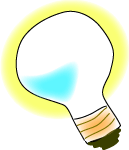

A struct is a bundle of variables that
has a name.
The variables of a struct are called its
members.
For example, the following struct has
the name bulb and contains two members,
watts and lumens.
Think of the struct as representing a light bulb
that has particular values for watts and lumens.
struct
{
int watts;
int lumens;
} bulb;
The declaration allocates memory for the struct
and provides for a way to access its
members using dot notation:
bulb.watts and bulb.lumens.
The syntax of struct declaration is this:
struct tag { member-list } variable-list;
The tag is the name of the type of struct
being declared.
The tag is optional if there is a variable-list.
The member-list is a list of items
that make up this struct.
The variable-list is a list of identifiers.
Each identifier is the name of a variable of this type of struct.
The variable-list is optional if there is a tag.
Here is a declaration of three variables:
struct
{
int watts;
int lumens;
} bulb20, bulb60, bulb100;
Here is a declaration of a struct with a tag, but no variables.
struct BulbType
{
int watts;
int lumens;
};
Following the latter declaration, variables may be declared by using the struct's tag:
struct BulbType bulb20, bulb60, bulb100;